 |
||||||
|
KL TIME
|
Cameron Highlands ~ Places to Visit
from Kuala Lumpur HOME > VISITORS GUIDE > PLACES TO VISIT > DAY TRIPS OUT OF KL > CAMERON HIGHLANDS Cameron Highlands is the
country’s premier hill resort, offering low temperatures all year round,
flower gardens, strawberry farms, terraced tea plantations, orchards,
vegetable farms, rest houses, and colonial cottages amongst its
jungle-clad hills. First developed by the British in the 1920s, Cameron Highlands got its name from William Cameron, a British surveyor who was commissioned by the then colonial government to map out the area in 1885. When a road was constructed in 1931 from Tapah to the highlands, the British and the locals moved in to settle on the slopes of the mountain. They were soon followed by tea planters and vegetable growers who found the fertile soil and cool climate to be especially suitable for the growing of their crops. The highlands are now the
major producer of vegetables for the nation that have earned it the title
"Green Bowl of Malaysia". As you proceed uphill you will come across Cameron Highlands three townships; namely Ringlet, Tanah Rata and Brinchang. Far from rural, the main
townships of Tanah Rata and Brinchang are highly developed with a wide range
of facilities and services with Hotels, resorts, apartments and shopping blocks,
providing accommodation and leisure activities for its many visitors. This charming little town of
7,000 or so residents with its many shops, eateries, banks, and government
buildings is considered as the hub of Cameron Highlands. As Cameron Highlands is a
popular tourist spot, most of the infrastructure is modern, so you can find
all the conveniences you need. Walking around is mostly safe at day or
night. There are some 3,642 hectares
(9,000 acres) of forest with jungle trails leading to scenic spots,
waterfalls and aboriginal villages. Most of the tracks here begin at Tanah
Rata. There are more than 14 paths to pick and choose from. Depending on its
distance, some routes can take as long as five hours to cover
Such a “use and throw” eco
friendly bamboo baskets are gradually being replaced by plastic baskets,
that could be used many times. The subsequent decline in market demand is
affecting their livelihood. In way of assisting them the tourism sector is
bring in tourists to visit and purchase some of the items. The waterfall cascades over several tiers of granite slopes, with the last drop at 25 meters high flowing into a small pool below, before resuming its journey as a narrow stream. Its surrounding jungle is home to a large variety of exotic insect and plant life. On weekends, the waterfall is
overrun by tourists and local visitors, who congregate tightly under the
cold shower of the falls. What all share in common is a culture intrinsically tied to the rainforest environment - Their livelihoods are sustained by its harvests; in hunting, fishing, collecting and farming. In the Cameron Highlands, most of the Orang Asli come from the Temiah tribe. These people live mostly in villages and settlement areas stretching from the foothills of Tapah all the way up to Brinchang. Try the Blowpipe and get to
know their weapons, tools, musical instruments etc. Observe the traditional
bamboo huts built only with bamboos, wood and palm leaves. A short walk
around the village with our guide will reveal some of the medicinal plants
used by the Orang Asli’s. Highlands strawberries tend to
be slightly smaller than those grown in Europe, probably due to a lack of
long sunshine hours to promote growth, although they can be just as sweet
and delicious. Initially the crop was grown in the ground in the traditional
way, today many are grown hydroponically, a method of growing without soil
on raised trays fed by water containing the essential nutrients for healthy
growth.
Most strawberries are sold to visitors as fresh fruit or jam. Always worth a visit for their novelty value and the chance to taste strawberries and cream!
The view of green rolling
hills, with the neat regular rows of tea plants, it’s such a relaxing
feeling. Today, the many tea plantations that dominate the valley are
instrumental in drawing the multitudes of visitors Cameron Highlands
receives each year.
Take a tour around the factory
to learn a little about tea-processing. It takes you through the various
stages that involve withering, rolling, fermenting, drying, sorting, tasting
and storing. Some of the machinery dates back to 1935 and is still in superb
working order! After the factory tour, visitors can walk the grounds or head off to the tea shop for that relaxing cuppa tea. The Boh Tea Garden is open daily from 9am to 4.30pm, but closes on Mondays.
Walking up the steps, visitors
will pass through gardens perched along the slopes of the small hill. The blooms here include the
"black" and "green" roses. Other than roses it also flower nurseries
producing beautiful blooms such as chrysanthemums, carnations, dahlia,
geraniums and others. The bazaar occupies two tarmac clearings opposite each other across the main road; one faces Star Regency Hotel, while the other lies along the police station. Better to walk as parking will be a pain. Note - It's best to visit not on weekends and during peak seasons; check the local calendar for a list of national and school holidays. You don't want to be around on such periods as the vehicle and human traffic is immensely heavy.
Overland Tour to Cameron
Highlands
| |||||
|
This site is
owned and managed by Capslock © 2014. All rights reserved. |
||||||


 Located
about 4 hours drive or 200 kilometres (120 miles) North from Kuala Lumpur,
the journey will take you along the North – South highway; Turning off at
Tapah and upwards on the main highland road that hugs the hill slopes, the
road curves in and out following the contours of the highlands.
Located
about 4 hours drive or 200 kilometres (120 miles) North from Kuala Lumpur,
the journey will take you along the North – South highway; Turning off at
Tapah and upwards on the main highland road that hugs the hill slopes, the
road curves in and out following the contours of the highlands. 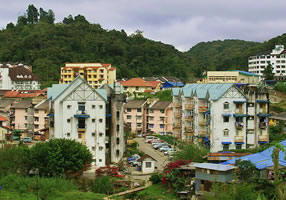 About
3km from Tanah Rata is is the main town of Brinchang. The township which is surrounded by hills
and terraced by vegetable farms, flower gardens and tea plantations, is the
centre of the highlands.
About
3km from Tanah Rata is is the main town of Brinchang. The township which is surrounded by hills
and terraced by vegetable farms, flower gardens and tea plantations, is the
centre of the highlands.  Basket
Weaving
Basket
Weaving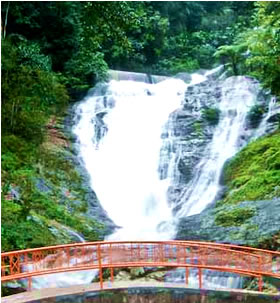 Iskandar Waterfalls
Iskandar Waterfalls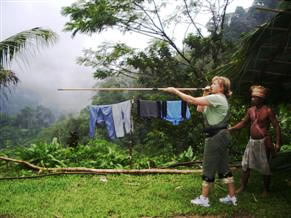 Aborigines
- Orang Asli
Aborigines
- Orang Asli
 Strawberry
Farms
Strawberry
Farms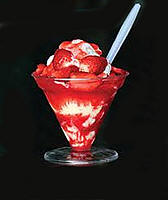 You
will not only have the opportunity to see how strawberries are cultivated
but also offer opportunity to purchase freshly picked strawberries with
thick delicious fresh cream at affordable prices. A basket is given to place
their pickings, and weighted and charged accordingly at the exit. The price
usually hovers around MYR20-25 for half a kg, which is significantly higher
than buying them from markets; you are in essence paying for the farm visit
and plucking experience.
You
will not only have the opportunity to see how strawberries are cultivated
but also offer opportunity to purchase freshly picked strawberries with
thick delicious fresh cream at affordable prices. A basket is given to place
their pickings, and weighted and charged accordingly at the exit. The price
usually hovers around MYR20-25 for half a kg, which is significantly higher
than buying them from markets; you are in essence paying for the farm visit
and plucking experience. 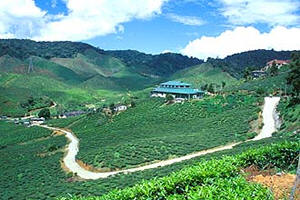 Tea
Plantation
Tea
Plantation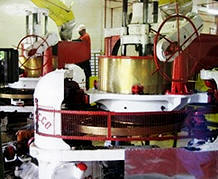
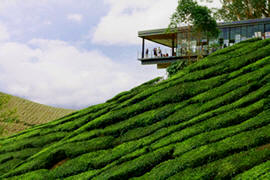
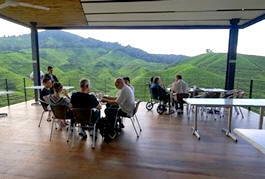
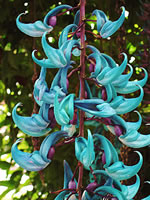 Rose
Centre
Rose
Centre